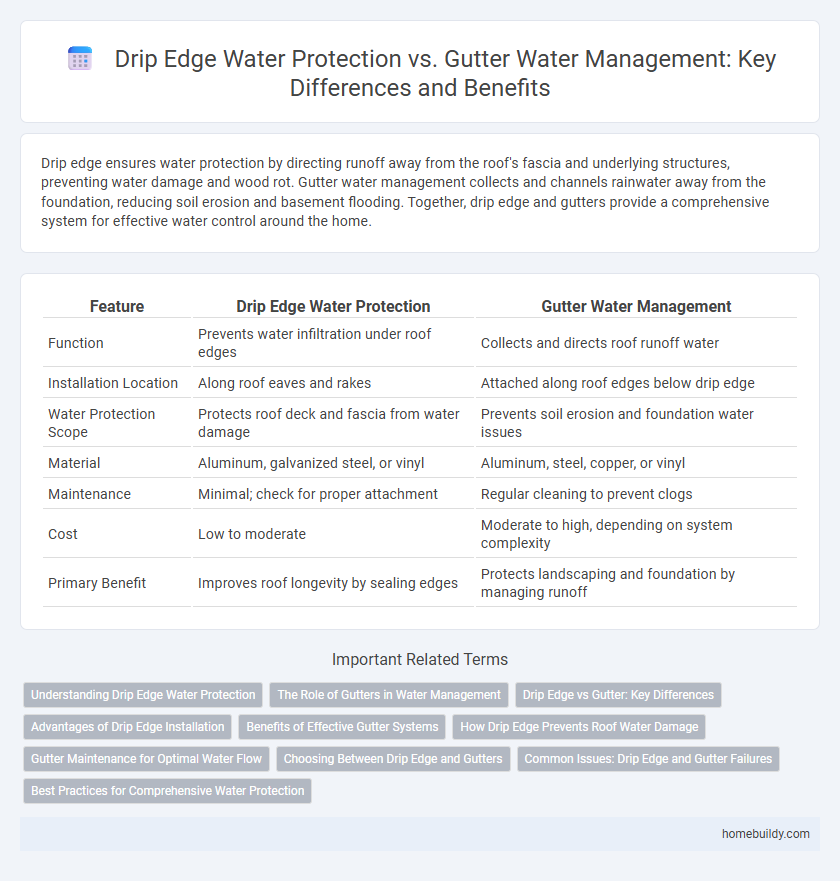Drip edge ensures water protection by directing runoff away from the roof's fascia and underlying structures, preventing water damage and wood rot. Gutter water management collects and channels rainwater away from the foundation, reducing soil erosion and basement flooding. Together, drip edge and gutters provide a comprehensive system for effective water control around the home.
Table of Comparison
| Feature | Drip Edge Water Protection | Gutter Water Management |
|---|---|---|
| Function | Prevents water infiltration under roof edges | Collects and directs roof runoff water |
| Installation Location | Along roof eaves and rakes | Attached along roof edges below drip edge |
| Water Protection Scope | Protects roof deck and fascia from water damage | Prevents soil erosion and foundation water issues |
| Material | Aluminum, galvanized steel, or vinyl | Aluminum, steel, copper, or vinyl |
| Maintenance | Minimal; check for proper attachment | Regular cleaning to prevent clogs |
| Cost | Low to moderate | Moderate to high, depending on system complexity |
| Primary Benefit | Improves roof longevity by sealing edges | Protects landscaping and foundation by managing runoff |
Understanding Drip Edge Water Protection
Drip edge water protection effectively directs water away from the roof's fascia and underlying wood, preventing water infiltration and damage over time. Unlike gutter water management, which collects and channels runoff, a drip edge ensures water flows off the roof edge cleanly, reducing the risk of rot and mold. Installing a proper drip edge enhances the roof's durability by maintaining the integrity of the roofing materials and supporting structures.
The Role of Gutters in Water Management
Drip edge is essential for directing water away from roof edges, preventing water damage to underlying structures, while gutters play a critical role in channeling rainwater away from the foundation to avoid soil erosion and basement flooding. Gutters support efficient water drainage by capturing runoff from the drip edge and roofing materials, ensuring controlled water flow and protecting landscape and structural integrity. Together, drip edges and gutters form a comprehensive water management system that mitigates moisture-related issues in residential and commercial buildings.
Drip Edge vs Gutter: Key Differences
Drip edge directs water away from the roof edge, preventing water infiltration and protecting roofing components, while gutters collect and channel rainwater away from the foundation. Drip edge serves as a first line of defense by managing runoff at the roof edge, whereas gutters handle larger volumes of water after it flows off the roof. Understanding these distinctions is essential for optimizing roof water protection and preventing structural damage.
Advantages of Drip Edge Installation
Drip edge installation enhances roof water protection by directing runoff away from fascia and underlying wood, preventing water damage and rot. It improves the lifespan of roofing materials by reducing water infiltration at the eaves and preventing ice dams. This simple metal flashing also helps maintain proper roof ventilation and supports effective gutter performance by ensuring water flows directly into the gutters without seeping behind them.
Benefits of Effective Gutter Systems
Effective gutter systems channel rainwater away from the roof edge, reducing the risk of water damage to the foundation and landscaping. Drip edge enhances this by directing water into gutters, preventing infiltration under roofing materials and protecting fascia boards. Together, they ensure optimal water management, extend roof lifespan, and minimize costly repairs.
How Drip Edge Prevents Roof Water Damage
Drip edge directs water away from the roof deck, preventing water from seeping into the fascia and underlying roofing materials, which reduces the risk of rot and structural damage. By extending beyond the roof edge, drip edge ensures water drains directly into the gutter, optimizing gutter water management and minimizing overflow. Effective drip edge installation forms a critical barrier against water infiltration, enhancing the roof's durability and protecting the building envelope.
Gutter Maintenance for Optimal Water Flow
Drip edge plays a crucial role in directing water away from the roof deck, preventing water intrusion and damage to the fascia and underlying structures. Proper gutter maintenance, including regular cleaning and inspection, ensures optimal water flow, preventing clogs and overflow that can lead to foundation erosion and landscape damage. Combining drip edge installation with well-maintained gutters enhances overall water management, protecting the building envelope from water-related issues.
Choosing Between Drip Edge and Gutters
Drip edge offers precise water protection by directing runoff away from fascia and roof decking, preventing water damage and rot at the roof edge. Gutters manage larger volumes of water by channeling rainwater away from the foundation, reducing soil erosion and basement flooding risks. Choosing between drip edge and gutters depends on climate, roof design, and the specific need for edge protection versus broader water management.
Common Issues: Drip Edge and Gutter Failures
Drip edge protects roofing edges by directing water away from fascia and underlying wood, preventing rot and water infiltration, while gutters manage large volumes of runoff from the roof surface. Common issues with drip edge failures include improper installation leading to water seepage behind the fascia, accelerating wood decay. Gutter failures often stem from clogging, poor slope, or damage, causing overflow that can compromise the drip edge's effectiveness and damage the building structure.
Best Practices for Comprehensive Water Protection
Drip edge ensures roof water flows away from the fascia and underlying roof components, preventing water infiltration and wood rot at the roof edges. Gutter water management channels collected runoff away from the foundation to avoid soil erosion and basement flooding. Combining properly installed drip edges with well-maintained gutters creates a comprehensive water protection system that safeguards both the roof structure and building foundation.
Drip edge water protection vs Gutter water management Infographic

 homebuildy.com
homebuildy.com